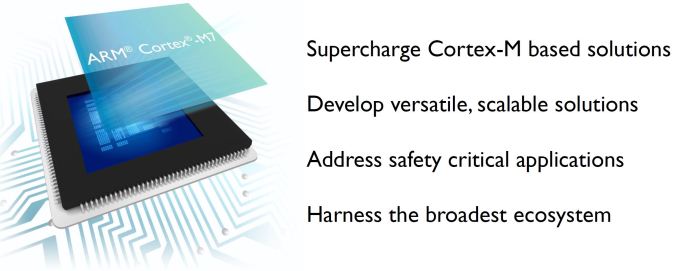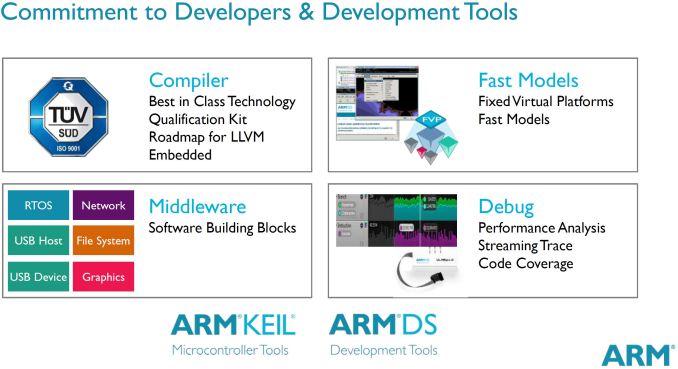Cortex-M7 Launches: Embedded, IoT and Wearables
by Stephen Barrett on September 23, 2014 7:01 PM ESTFinal Words
In the past two days we have seen two announcements targeting IoT and wearable devices from major semiconductor companies. These announcements may seem premature as there hasn’t been a game changing device release like the original iPhone was, but the companies involved are simply doing what they have done before and investing in the future. Much of ARMs work before the ARM11 processor was behind closed doors or simply unnoticed by consumers at large, but it was there. Watching the suppliers evolve to provide suitable products, documentation, and tooling for something new is exciting.
The Coretex-M7 processor pushes the performance of ARMs dedicated MCU line to new levels, helping ARM further consolidate MCUs and DSPs into a single ARM ISA compatible 32-bit CPU. The increased performance and features also allow device makers to rely more on the always on MCU and power up the AP much less often, improving overall power consumption and even enabling devices that were previously impractical.
ARM also invested in improving the interrupt latency of the M7 and provides qualification kits for safety critical standards like ISO 26262 (automotive) and IEC61508. Anyone with experience here knows just how expensive creating these kits can be.
For major MCU SoC vendors like ST, Atmel, NXP, Freescale, TI, and others, the prospect of integrating a CPU core off-the-shelf from ARM means less R&D investment in processor design and documentation with a potentially greater payoff by tapping into the ARM ecosystem. Additionally, rather than hand coding their own development IDEs and compilers, they can serve their users with existing open source alternatives. To consumers, consolidation could bring similarities to the Windows + Intel days when software developers gained immense efficiency.
Many IoT and wearable devices today accomplish their roles using high power A series application processors. This is by design, as the companies providing them simply reused their smartphone processors to get product to market as fast as possible. Designing a heterogeneous system using MCUs and application processors is more complex but the benefits are undeniable. As the IoT and wearable devices mature, we will keep a close eye on the underlying technology of future devices and hope to report some positive changes over the next year.












43 Comments
View All Comments
Guspaz - Tuesday, September 23, 2014 - link
"General purpose operating systems such as Linux (Android), Windows, OSX, and iOS require an MMU to function. That means M series processors, like all microcontrollers (MCUs), will never be tasked with running general purpose operating systems."This is incorrect: Linux runs on the Cortex M and other platforms that lack an MMU via uClinux. There are some differences, yes, but for the most part it's transparent to the developer, and most software runs unmodified.
extide - Tuesday, September 23, 2014 - link
This is true, but there are some pretty big limitations when using uClinux. I wouldn't suggest it unless you really really need it, heh.HardwareDufus - Tuesday, September 23, 2014 - link
Like the Cortex-M3 & M4, it is a 32-bit ARMv7-M core processor. I is said to use a six-stage superscalar pipeline.The ARM press release says that it will have highly flexible system and memory interfaces. Looking forward to seeing more details on that... (though of course it will lack a MMU).
It launches manufactured on a 40nm process and runs up to 400Mhz.
However it will move to a 28nm process in the near future, where performance is expected to double (so one can assume a near doubling of clock speed as well).
Atmel is already said to have a license. Will be interesting to see if the Arduino folks pick this processor up for a new Arduino board. Arduino has picked up the Cortex-0+ for the new Arduino ZERO and uses the Cortex-M3 for the Arduino DUE. But they've yet to use the Cortex-M4. Their latest board, the Arduino TRE uses a Texas Instruments Sitari chip which is a Cortex A series processor. So who knows what direction they are moving in.
Texas Instruments licenses the Cortex-M processors, but I haven't heard of a license for this new processor. I just picked up a nice development board that uses the Cortex-M4 from TI.
HardwareDufus - Tuesday, September 23, 2014 - link
Yes, I over used the phrase 'picked up' and cannot edit it. Feel free to substitute chose, selected, employed, used, etc...xenol - Wednesday, September 24, 2014 - link
Speaking from someone who's used MCUs and the M3/M4 series micro-controllers in development (professionally and hobby), I don't really see a point in using a general purpose OS on a small footprint. Something like this should be doing one thing and doing it very well.There are plenty of RTOSes out there that take up a very tiny footprint that will do memory management and "thread management" for you if you need it. Heck all of my projects have gotten away with doing amazing things without needing a heap (i.e., calling malloc).
The biggest thing I don't like about uCLinux is it requires external RAM. A lot of development boards don't have them.
akdj - Sunday, September 28, 2014 - link
Im curious as to which RTOS, micro controller or any other 'hobby or professional' use case that rivals this M7? It's footprint, efficiency, capabilities and phenomenal 'future' opportunities this motion sensor will provide. You're using vacuum tubes. As are all wearables to date. Those utiliIng this new ARM architecture will be moving directly to SolidState. Overnight. It's THAT HUGE!Best to 're-think' your tools and options, as using a micro-controller in your new project slated for mid 2015 release will be chewed up and spat to the floor by anyone using a 'currently available' M7. Difference between a typewriter and computer with Word Prodessor, with today's capabilities!
J
isa - Tuesday, September 23, 2014 - link
I can't apologize enough for my profound ignorance and stupidity, but what exactly were the 2 similar IoT anouncements on Anandtech in the last 2 days as referenced in the article? I can only find the Mediatek announcement. In the future, links to references would help stupid people like me.extide - Tuesday, September 23, 2014 - link
Mediatek, and this oneloftie - Tuesday, September 23, 2014 - link
If the embargo on the slides are correct, you published an hour early.Stephen Barrett - Tuesday, September 23, 2014 - link
Yeah the CMS failed me on daylight savings. Hopefully we will be forgiven ;-)